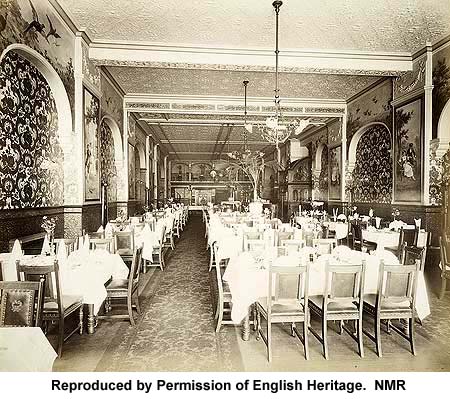The Mosley Hotel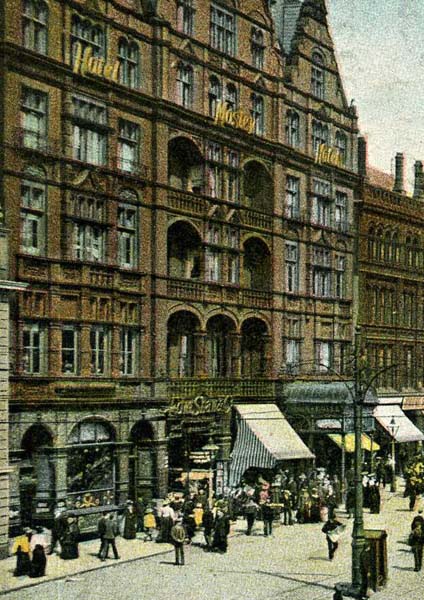 The Mosley Hotel
occupied a prominent position on Piccadilly across from
the northern end of the Piccadilly Gardens. It
formed part of a block of buildings that was bounded by
Tibb Street, Back Piccadilly, Oldham Street and
Piccadilly.
So far I have been unable to pin down when the Mosley Hotel was built. I do know that by 1816 the number of coaches serving Manchester had increased dramatically resulting in a marked increase in trade between the city and the provinces. One consequence of this was that a number of hotels were opened on Market Street and at the top of Mosley Street to cater for travellers. In a book called "Reminiscences of Manchester Fifty Years Ago" by Josiah Thomas Slugg, published in 1881, a reference is made to the hotel. In Chapter 3 entitled "Calico Printers" it says this: "John Whitehead was a crofter or bleacher at Levenshulme, but towards the close of the last century he began calico printing at Breightmet, and lived at Ainsworth Hall. Early in the present century the business devolved on his three sons, John, James and Thomas. The latter lived at Bank House, Bolton; whilst James lived in Piccadilly, in one of the two houses now the Mosley Arms Hotel." This would seem to suggest that James lived in a house at this location before it became part of the Mosley Arms Hotel and that this was sometime in the early 1800s. By the time the 1844 - 1849 map of the city was drawn the Mosley Arms Hotel is there. Its next-door neighbour is the White Bear Inn. It is worth noting that on this map there is a gap between the Mosley Arms Hotel and the White Bear which doesn't exist in the image of the hotel above suggesting that after 1849 the Mosley Arms changed in appearance. 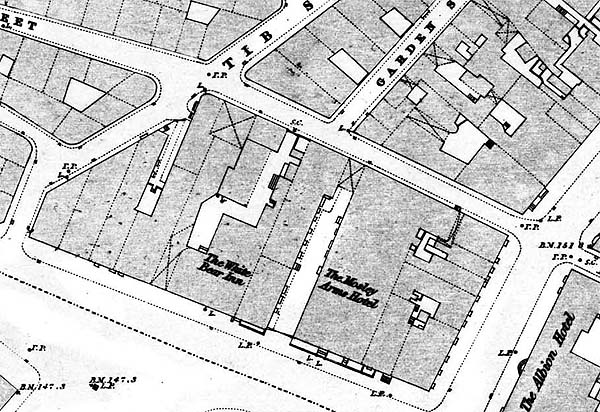 The image of the Mosley Hotel, seen above, doesn't give the impression that it was once two houses converted into a hotel. It looks like a purpose built hotel building. So what are the possibilities? It could be that the house that James lived in and its neighbour became the Mosley Arms Hotel but then they were either converted into or replaced by the building above. The difference between the 1844 map above and the 1888 map below shows that the gap between the Mosley and the White Bear has been filled in. This suggests that the building that was there in 1844 was different from the one shown at the top of this page that was there in 1888. At this point all we can say for sure is that A Mosley Arms Hotel sat at this location from around 1844 but may have been there in one form or another for a decade or more before that. 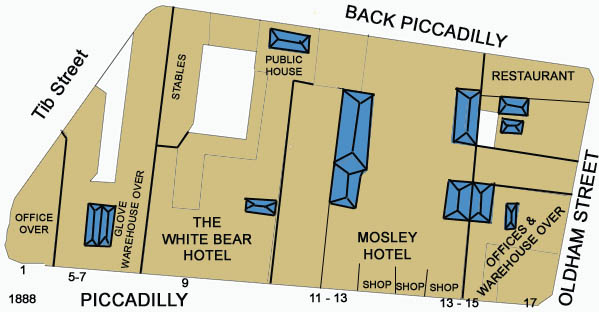 By 1888 it was
known as The Mosley Hotel.
Steven Murray
is a relative of John Richardson, the man who
took over the running of the Mosley Hotel in
1813. Mr. Murray sent me the following
account of the hotel's history:
"The original
Moseley Arms Inn was situated at No 63 Market
St situated between the Bridgewater Inn and
Spring Gardens. This was one of Manchester's
busiest coaching inns.
In 1813 the Moseley Arms Inn was taken over by a Mr John Richardson originally from Wigton, who had previously been the tenant of the Royal Oak (another busy coach house ) in Chorley. The Moseley Arms Hotel was to prove a successful and lucrative business for him. In the late 1820's plans were put forward to redevelop Market St. It was obvious that the Railways were coming to Manchester (it happened in 1830) so things were not looking good for the coach trade, consequently in 1828 John Richardson purchased two large houses in Piccadilly, one as stated by you owned by John Whitehead of the bleaching family, the other owned by a Mrs Podmore who was apparently revered as a famous beauty. John Richardson amalgamated the two houses as a hotel and then transferred his business in Market St to that address (No 13 Piccadilly) renaming it the Moseley Arms Hotel . Incidentally, John Richardson was one of the founders, (in 1824) and a hereditary governor of the Royal Manchester Institution. He died in 1833. Ownership of the Hotel passed to his family and it was managed by his son James, assisted by his sisters and their stepmother . (Incidentally his first son and heir John jnr was a victim of a family dispute and was cut out of John's will completely, James then inheriting) Coaches ceased to run from the Hotel soon after John's death but James was well able to cope with the changing business scene and was soon attracting the highest clientele to the hotel. The Moseley was considered one of the four best hotels in Manchester and a rival to the Midland. In 1836 Manchester City Corporation purchased the ancient manorial rights from Sir Oswald Moseley and celebrated the event with some pomp. The mayor and members of the City council on the occasion of the annual fair made the official proclamation of the event from the hotel steps, and then went inside for a celebratory banquet prepared by James' staff. Also in 1836 there was a grand musical festival in the city and the famous and talented opera singer Maria Malibran stayed at the hotel. Unfortunately she fell ill and died and her body lay in state at the hotel, thousands of people came to pay their respects. In 1848 the radical lawyer Ernest Jones was arrested in the hotel by the police, on a charge of sedition for a speech he had made in London. Mr Jones went on to defend the Fenians who were charged with murdering Sgt Brett under the railway arch on Hyde Road. James went into semi retirement in 1858, the hotel passing to his sisters. He died there in 1867. The façade of the hotel as seen was built sometime in the 1880's and the hotel went out of the Richardson family sometime at the turn of the century." 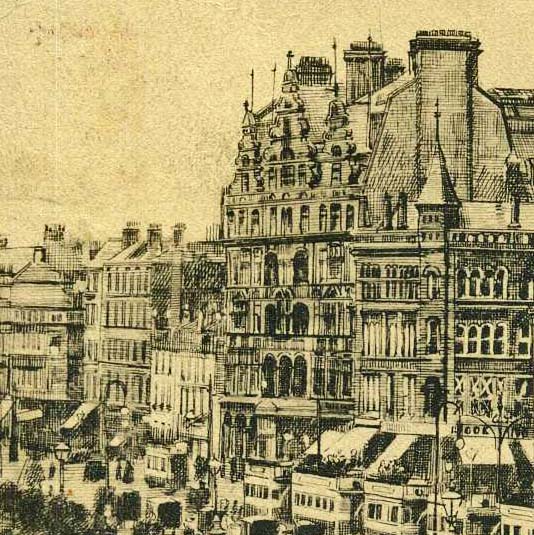 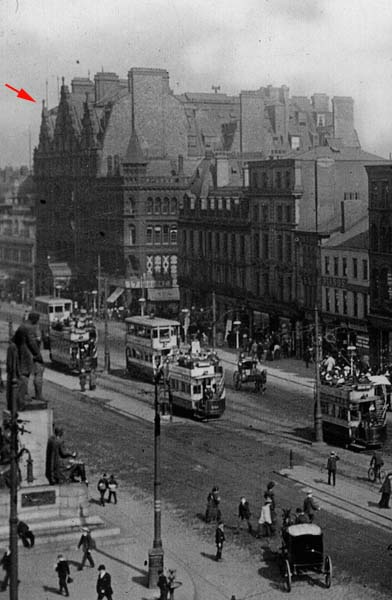 The hotel building was replaced in 1922 by a "Beaux Arts" building designed by Percy Hothersall. It was home to "The Piccadilly" cinema and can be seen below next door to the oriental looking Kardoma Cafe. 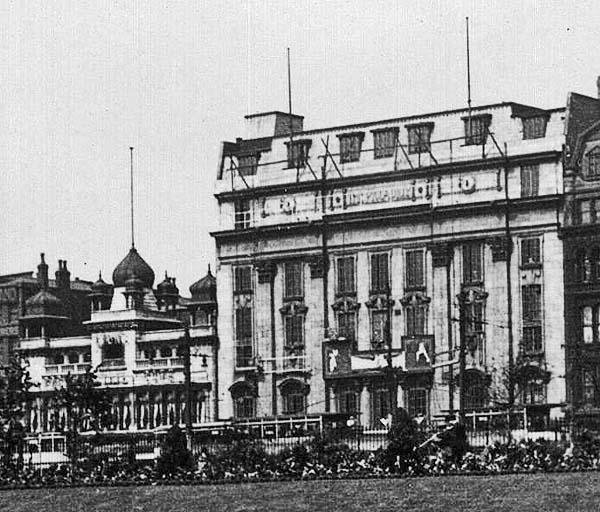 In the image
below you can see the Piccadilly Cinema showing
"Stand Up And Cheer" starring Shirley Temple and
released in 1934. You will also note that
the Kardoma Cafe is now a Lyons Cafe.
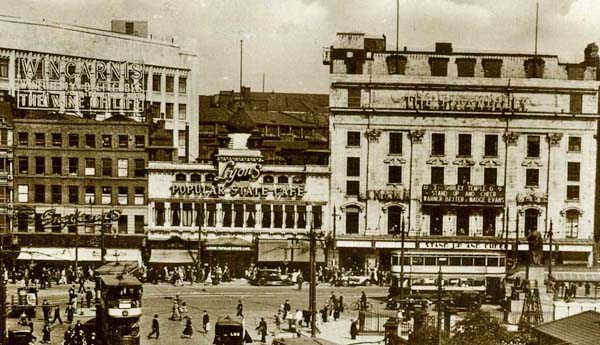 After the cinema closed, the building was transformed into a Littlewoods store. Today it is home to Somerfields, Boots and Bella Italia. 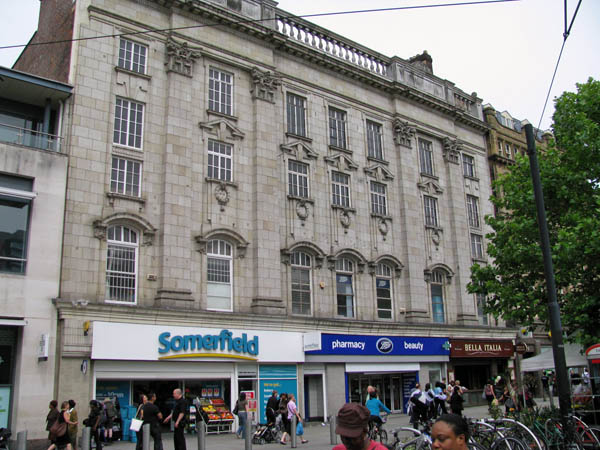 Close Window |
